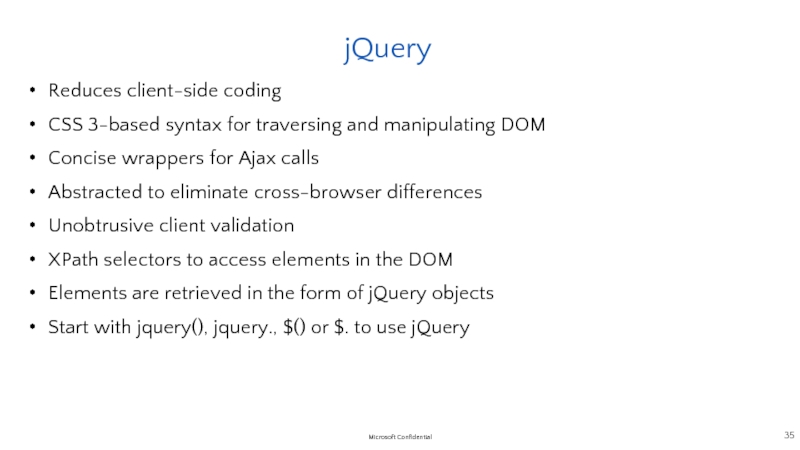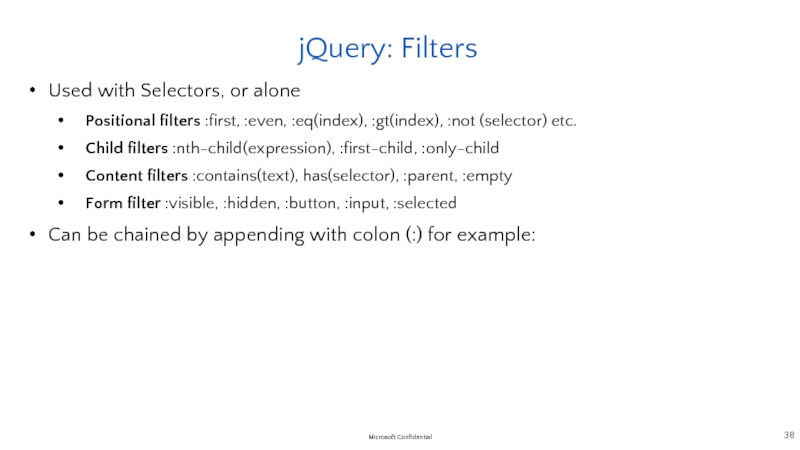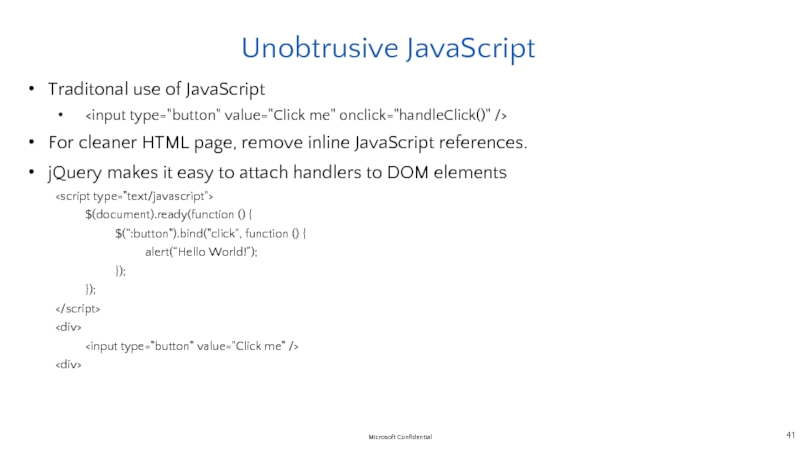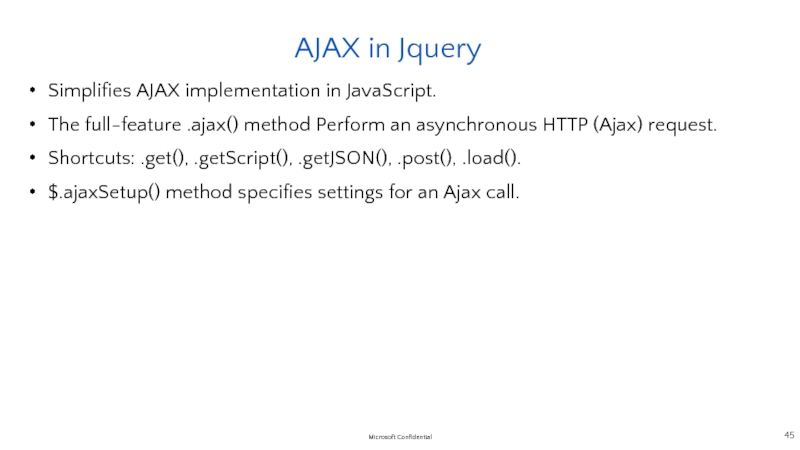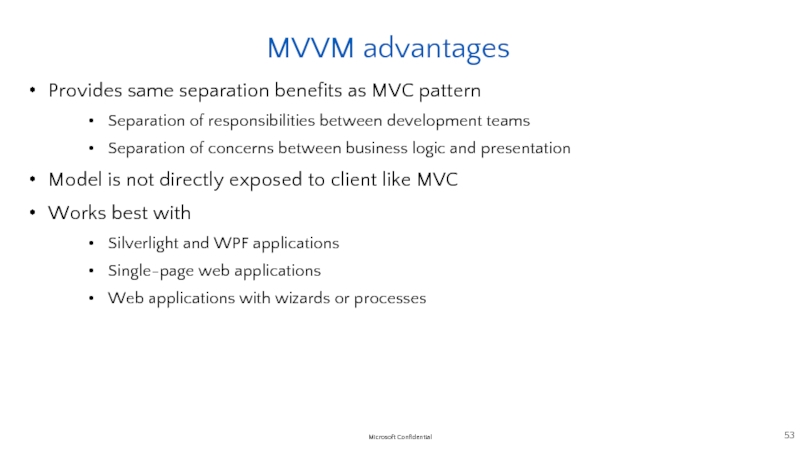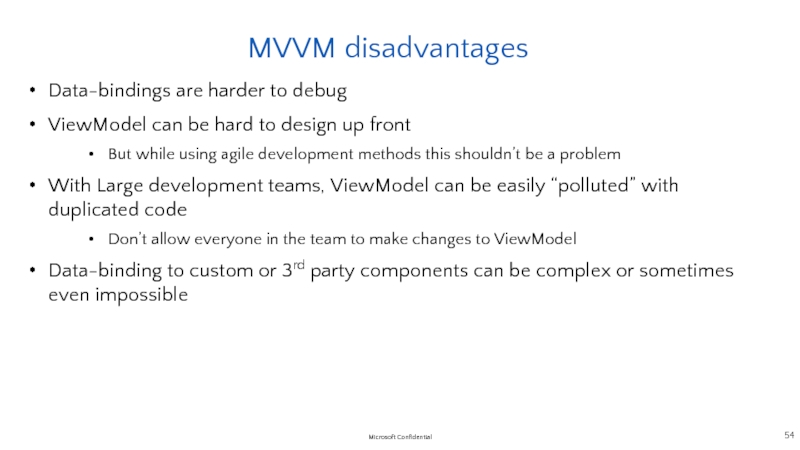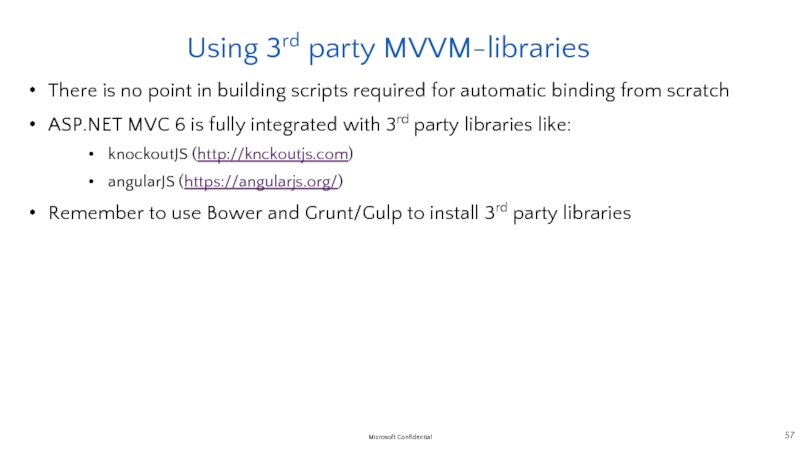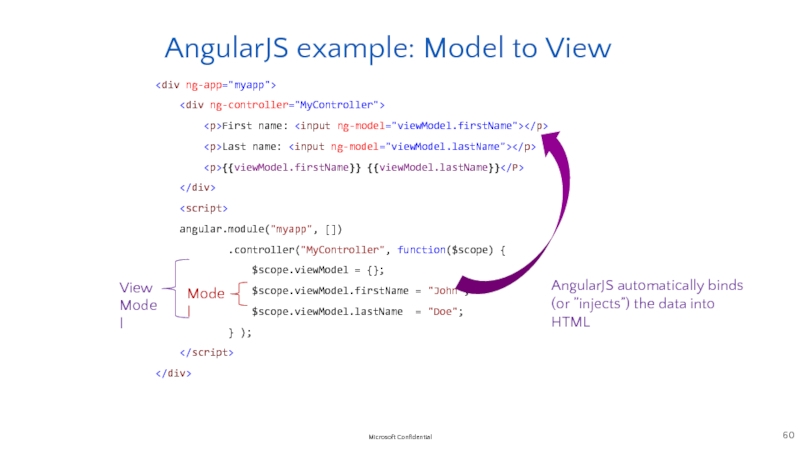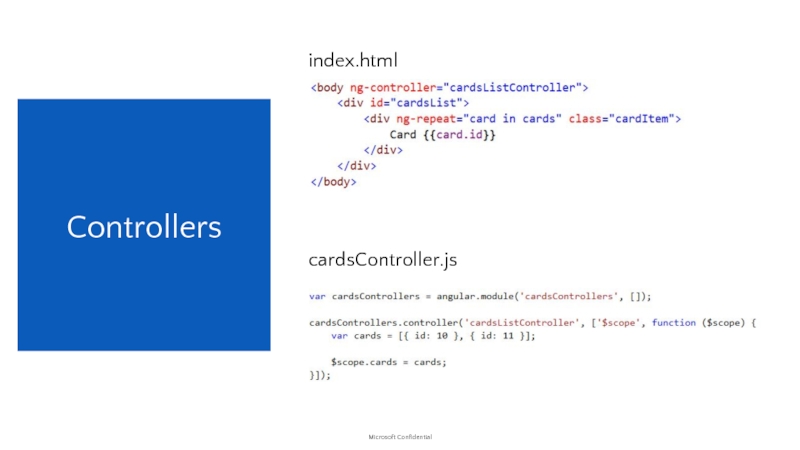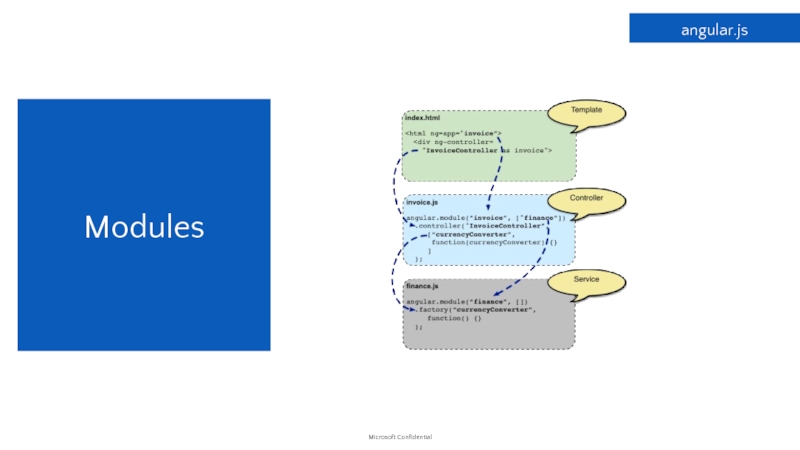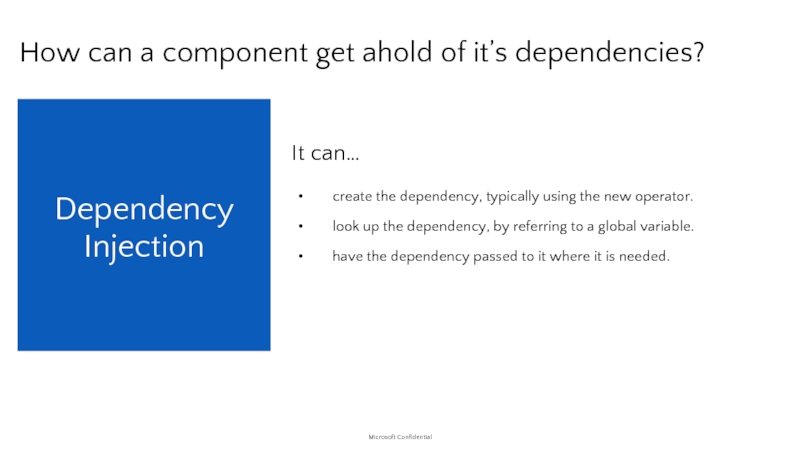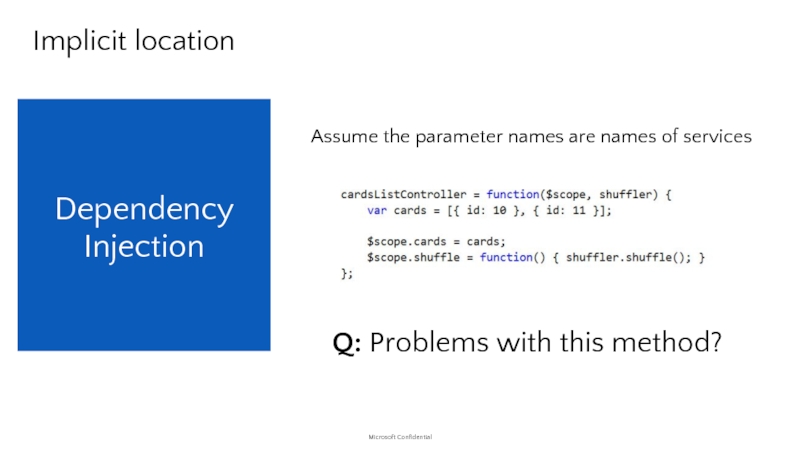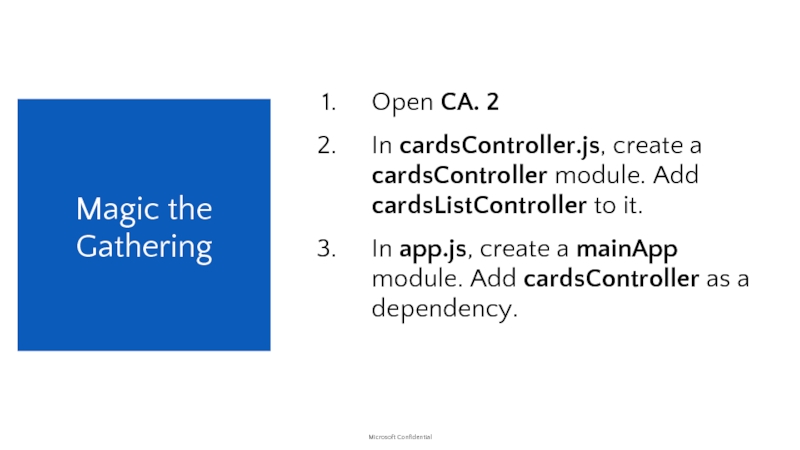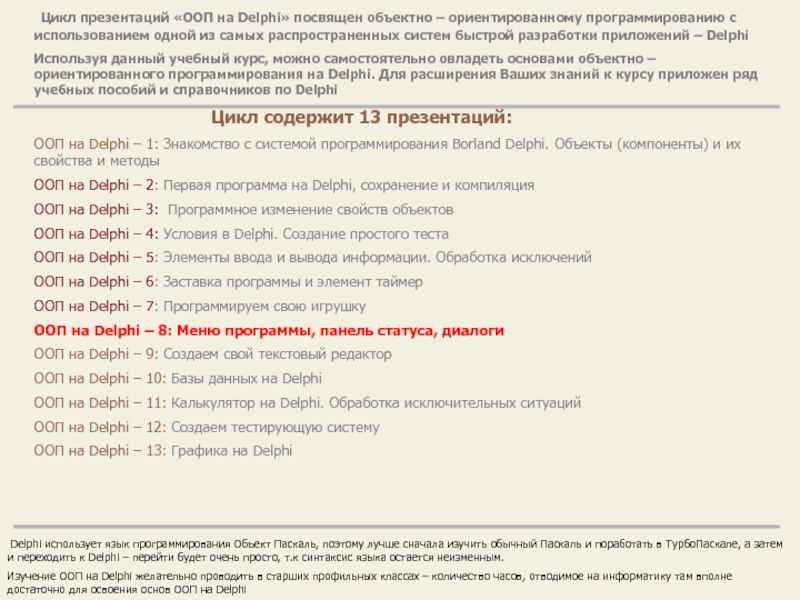- Главная
- Разное
- Дизайн
- Бизнес и предпринимательство
- Аналитика
- Образование
- Развлечения
- Красота и здоровье
- Финансы
- Государство
- Путешествия
- Спорт
- Недвижимость
- Армия
- Графика
- Культурология
- Еда и кулинария
- Лингвистика
- Английский язык
- Астрономия
- Алгебра
- Биология
- География
- Детские презентации
- Информатика
- История
- Литература
- Маркетинг
- Математика
- Медицина
- Менеджмент
- Музыка
- МХК
- Немецкий язык
- ОБЖ
- Обществознание
- Окружающий мир
- Педагогика
- Русский язык
- Технология
- Физика
- Философия
- Химия
- Шаблоны, картинки для презентаций
- Экология
- Экономика
- Юриспруденция
Net framework: developing modern web apps with asp.net mvc презентация
Содержание
- 1. Net framework: developing modern web apps with asp.net mvc
- 3. How to View This Presentation Switch to
- 4. Module 6: Client-Side Development Module Overview MVC
- 5. Module 6: Client-Side Development Section 1: Support Lesson: MVC and JavaScript
- 6. Why using JavaScript in ASP.NET MVC? Combining
- 7. Project Template – wwwroot folder All static
- 8. Project Template – JavaScript Libraries Part 1
- 9. Project Template – JavaScript Libraries Part 2
- 10. Project Template – JavaScript Libraries Part 3
- 11. Client-Side Development Configuration Files gulpfile.js Javascript Configuration
- 12. Module 6: Client-Side Development Section 1: Support Lesson: Bower and Gulp
- 13. Why using Gulp (or Grunt) and Bower?
- 14. What is Bower? “A package manager for
- 15. What is Gulp? “The JavaScript Task Runner”
- 16. Bundling and Minification Bundling reduces the number
- 17. Demo: Bower and Gulp
- 18. Module 6: Client-Side Development Section 2: Techniques Lesson: Styling with Bootstrap
- 19. Intro to Bootstrap
- 20. Why use it? CSS is can be
- 21. Browser Support Support the latest version of browsers on the following systems:
- 22. Bootstrap Features Theme Support Responsive Grid
- 23. Theme Support (Default)
- 24. Easy Theme Support (Custom)
- 25. Responsive Layout
- 26. Responsive Layout
- 27. Grid System
- 28. Grid System
- 29. Components Reusable components built to provide navigation, alerts, progress bars, pagination and many more.
- 30. Visual Studio – Class Intellisense
- 31. Visual Studio – Missing Class Detection
- 32. Module 6: Client-Side Development Section 2: Techniques Lesson: JavaScript and jQuery
- 33. Using JavaScript in MVC 6 JavaScript scripts
- 34. jQuery and Microsoft Lightweight open source JavaScript
- 35. jQuery Reduces client-side coding CSS 3-based syntax
- 36. jQuery: Selectors Execute commands on a single
- 37. jQuery: Selectors (continue) Specific operators are used
- 38. jQuery: Filters Used with Selectors, or alone
- 39. jQuery: Methods Class/Style Methods Use to apply
- 40. jQuery: Events jQuery simplifies events implementation Events
- 41. Unobtrusive JavaScript Traditonal use of JavaScript
- 42. Module 6: Client-Side Development Section 2: Techniques Lesson: AJAX
- 43. Ajax - (Asynchronous JavaScript and XML) Send
- 44. AJAX Engine Javascript Engine
- 45. AJAX in Jquery Simplifies AJAX implementation in
- 46. MVC’s AJAX Helpers Methods providing and simplifying
- 47. Ajax in Actions – Get Request Either enable Get requests in code like this:
- 48. Ajax in Actions Or create a new ActionMethodSelectorAttribute
- 49. Module 6: Client-Side Development Section 3: Single Page Application Lesson: Fundamentals
- 50. Single Page Application (SPA) In traditional web
- 51. SPA - Design Model View View Model
- 52. MVVM in general Main point in MVVM
- 53. MVVM advantages Provides same separation benefits as
- 54. MVVM disadvantages Data-bindings are harder to debug
- 55. Bringing MVVM to ASP.NET MVC You don’t
- 56. How it works SQL Repositories & Model
- 57. Using 3rd party MVVM-libraries There is no
- 58. KnockoutJS example: Model to View
- 59. KnockoutJS example: View to Model
- 60. AngularJS example: Model to View
- 61. MV* framework For Single Page Application
- 62. Data binding, as in {{}} DOM control
- 63. Concepts
- 64. What is a Controller? Controllers
- 65. Controllers index.html cardsController.js
- 66. What shouldn’t a controller do? Controllers
- 67. Open CA.1 Implement the cardsListController It should
- 68. What is a Module? You can think
- 69. Modules angular.js
- 70. Modules angular.js
- 71. Modules angular.js
- 72. What is Dependency Injection? Dependency Injection
- 73. create the dependency, typically using the new
- 74. How does the injector locate dependencies? Dependency Injection
- 75. Implicit location Dependency Injection Assume the parameter
- 76. Property Annotation Dependency Injection The $inject property
- 77. Inline Array Annotation Dependency Injection Define services inline when creating the controller. Q: Thoughts?
- 78. Open CA. 2 In cardsController.js, create a
- 79. $http $resources Filters Getting data angular.js angular-resource.js
- 80. What is a promise? Promises
- 81. Filters
- 82. Hands On Lab: Build a Single Page
- 83. Open CA.3 Modify cardsListController to read the
- 84. angular-animate.js SPA uses views to build
- 85. ngView Routing angular-route.js angular.js Module Components A
- 86. Route Provider Routing angular-route.js angular.js Module Components $routeProvider is used for configuring routes. config.route.js
- 87. Route Service Routing angular-route.js angular.js Module Components
- 88. Route Parameters Routing angular-route.js angular.js Module Components
- 89. HTML from view – no problem! HTML
- 90. Open CA.4 Add a filter to app.js
- 91. Open CA.5 Create a route that responds
- 92. Productivity Tools http://www.sidewaffle.com
- 93. Productivity Tools Batarang – Chrome Extension https://github.com/angular/angularjs-batarang
- 94. Module 6: Client-Side Development Section 1: Development Tools Lesson: Tools
- 95. jQuery – Tools / F12
- 96. jQuery – in Visual Studio Page Inspector
- 97. Module Summary MVC 6 support for client-side
- 98. Lab: Client-Side Development
Слайд 1< Engineer Name >
Premier Field Engineer
.NET Framework: Developing Modern Web Apps
WorkshopPlus
Слайд 3How to View This Presentation
Switch to Notes Page view:
Click View on
Use page up or page down to navigate
Zoom in or out as needed
In the Notes Page view you can:
Read any supporting text, now or after the delivery
Add your own notes
Take the presentation files home with you
Слайд 4Module 6: Client-Side Development
Module Overview
MVC 6 support for client-side development
Client-side files
Bower, Gulpjs/Gruntjs
Introduction to Bootstrap
Primer on JavaScript, Jquery and AJAX
Single Page Application explained (knockoutjs/angularjs)
Lesson name
Lab
Слайд 6Why using JavaScript in ASP.NET MVC?
Combining server-side and client-side processing.
More responsive
JavaScript comes in many forms:
AJAX – Partial page update and refresh
Jquery – Elegantly and Efficiently find and manipulate HTML DOM elements
MooTools – Modular JavaScript and code reuse
Prototype – Simplify development of dynamic web application
Node.js – Developing high performance JavaScript via multithreading model
Industry standard for modern web development
And many more
Слайд 7Project Template – wwwroot folder
All static files should be located in
wwwroot folder is the root of the website
http://hostname/ points to wwwroot
All static content should be relative to the folder
Code files should be places outside of wwwroot (C# or Razor).
Static files created through compilation or pre-processing should be copied into wwwroot.
Can be renamed by changing “webroot” setting in the project.json file.
Слайд 8Project Template – JavaScript Libraries Part 1
_references.js
Contains JavaScript reference in the
Allows Visual Studio to augment IntelliSense support for JavaScript
The autosync flag set to true:
JavaScript files are automatically be added.
Automatic update when a referenced file is moved.
Manual update is possible via right clicking on the file.
Bootstrap.js and bootstrap.min.js
HTML, CSS and JavaScript-based design templates for creating responsive web sites.
Note! Always use the .min version of a JavaScript file to improve load time.
Слайд 9Project Template – JavaScript Libraries Part 2
Bootstrap-touch-carousel & hammer.js
A slideshow component
Enable gestures on touch devices using hammer.js, a javascript library for multi-touch gestures.
Слайд 10Project Template – JavaScript Libraries Part 3
Jquery-version.intellisense.js
Extending IntelliSense for jQuery library
Jquery-version.js
Main JQuery version
Jquery-version.min.map
Allows to map to the un-minified version of JQuery for troubleshooting purposes.
Jquery.validate.js (Jquery.validate.min.js)
Provide client side validation using jQuery
Multilanguage support
Jquery.validate.unobtrusive.js and jquery.validate.unobtrusive.min.js
Слайд 11Client-Side Development Configuration Files
gulpfile.js
Javascript Configuration of Gulp tasks
Project.json
Main project file. NuGet
Package.json
Lists npm packages
Bower.json
Lists Bower packages
Слайд 13Why using Gulp (or Grunt) and Bower?
Modern web applications incorporate various
Easy management of client-side packages
Automating build tasks such as scripts compilation, bundling, minification or unit testing.
Leverage existing tools from the web development community.
Слайд 14What is Bower?
“A package manager for the web” (http://bower.io)
Installs and restores
Keeps track of all the packages in a manifest file, bower.json
Improves page load.
Слайд 15What is Gulp?
“The JavaScript Task Runner” (http://gulpjs.com)
An application to automates routine
gulpfile.js contains Gulp tasks with JavaScript-like configuration
Grunt is another task runner.
Gulpfile.js uses JSON-like syntax for configuration
Слайд 16Bundling and Minification
Bundling reduces the number of requests to the server
Combining multiple files into a single file.
Create CSS, JavaScript and other bundles.
Use the “Include” or “IncludeDirectory” of the Bundle Class
Minification reduces the size of the requested assets (CSS and JavaScript).
MVC 6 uses Gulp or Grunt to achieve bundling and minification.
Слайд 20Why use it?
CSS is can be tricky
Cross browser support can be
Solves basic tasks (e.g. page layout without tables)
Bootstrap 3 makes it easier
Слайд 22Bootstrap Features
Theme Support
Responsive
Grid
Components
Pagination
Buttons
Modal
Great Visual Studio support
Слайд 29Components
Reusable components built to provide navigation, alerts, progress bars, pagination and
Слайд 33Using JavaScript in MVC 6
JavaScript scripts can be defined inside a
Use the MVC @section tag to organize JavaScript scripts
The @RenderSection is used to inject JavaScript at a desired location inside the View.
For best practices, declare JavaScript scripts inside a .js file.
Use a minification tool in Visual Studio for optimization.
IntelliSence support for JavaScript in Visual Studio
Слайд 34jQuery and Microsoft
Lightweight open source JavaScript library
Deprecated Microsoft.Ajax libraries in favor
Distributed jQuery library with Visual Studio projects since 2008.
Extended Microsoft product support for jQuery
Enterprises can open jQuery support cases 24x7 with Microsoft Support.
Integrated Client template support
Default templates leverage jQuery
Слайд 35jQuery
Reduces client-side coding
CSS 3-based syntax for traversing and manipulating DOM
Concise wrappers
Abstracted to eliminate cross-browser differences
Unobtrusive client validation
XPath selectors to access elements in the DOM
Elements are retrieved in the form of jQuery objects
Start with jquery(), jquery., $() or $. to use jQuery
Слайд 36jQuery: Selectors
Execute commands on a single or multiple selected DOM elements.
Basic
Based on HTML elements IDs e.g.: $(“#main”)
Based on cascading style sheets (CSS) e.g.: $(“.header”)
Based on element tags e.g.: $(“div”)
Based on element attributes e.g.: $(“[type = ‘button’]”)
Build more complex selectors through combination
$(“#main p.quote”) ⬄ Select paragraphs with a “quote” CSS class located inside elements with IDs equal to “main”
$(this) operator
Слайд 37jQuery: Selectors (continue)
Specific operators are used to expand selection options
A white
The > operator selects direct child elements of the given ancestor e.g.: $(“div > p”) ⬄ $(“div”).children(“p”)
The + operator selects adjacent elements
e.g.: $(“div + p”) ⬄ $(“div”).next(“p”)
The ~ operator selects all siblings elements
e.g.: $(“div ~ p”) ⬄ $(“div”).nextall(“p”)
The comma operator selects all the specified elements
e.g: $(div, p, a)
Слайд 38jQuery: Filters
Used with Selectors, or alone
Positional filters :first, :even, :eq(index), :gt(index),
Child filters :nth-child(expression), :first-child, :only-child
Content filters :contains(text), has(selector), :parent, :empty
Form filter :visible, :hidden, :button, :input, :selected
Can be chained by appending with colon (:) for example:
Слайд 39jQuery: Methods
Class/Style Methods
Use to apply CSS styles to the result of
.addClass(), .css(), .height(), .position()
DOM Methods
.before(), .insertBefore(), .append(), .empty(), .attr()
Слайд 40jQuery: Events
jQuery simplifies events implementation
Events are triggered by the page or
Events are often used to attach a callback function
To bind an event:
Use of function to bind a event directly e.g.: .click()
Use .on() e.g.: .on(“click”, …)
Use .bind() e.g.: .bind(“click”, …)
Use .live() e.g.: .live(“click, …)
Слайд 41Unobtrusive JavaScript
Traditonal use of JavaScript
For cleaner
jQuery makes it easy to attach handlers to DOM elements
Слайд 43Ajax - (Asynchronous JavaScript and XML)
Send and receive data from a
Uses XMLHttpRequest object
JSON typically used instead of XML
Back button and bookmarking challenges
Downgrade challenges for mobile devices that don’t support JavaScript.
Webcrawlers don’t index pages created via Ajax
Does not work across domains by default
Слайд 44AJAX Engine
Javascript Engine
(eg Chakra)
Controller
Action Method
User Interactions / Events
GUI - HTML
Javascript Updates GUI
JSON
Browser
Server
Слайд 45AJAX in Jquery
Simplifies AJAX implementation in JavaScript.
The full-feature .ajax() method Perform
Shortcuts: .get(), .getScript(), .getJSON(), .post(), .load().
$.ajaxSetup() method specifies settings for an Ajax call.
Слайд 46MVC’s AJAX Helpers
Methods providing and simplifying client-side functionality implementation in MVC.
Asynchronous
Methods and extensions are called using the Ajax property of the view.
Use Request.IsAjaxRequest() for checking Ajax requests
Слайд 50Single Page Application (SPA)
In traditional web application, the server responds to
In SPA, the full page is loaded at initial request.
Subsequent interactions take place through Ajax requests without full page reload.
Better user experience
Some SPA frameworks
AngularJS
KnockoutJS
Backbone
EmberJS
DurandalJS
Hot Towel
Слайд 51SPA - Design
Model View View Model (MVVM) model
Variance of MVC
View faces
Commands within the ViewModel are triggered by the View
Changes in the ViewModel cause events that make the View update itself
If a new View is required, the ViewModel communicates this with the application to redirect the user
Model is the same
Слайд 52MVVM in general
Main point in MVVM is the binding of data
MVVM is widely used with Silverlight and WPF projects (where data binding is “built-in”
When MVVM is used with ASP.NET, view-model resides in client side (JavaScript)
Best choice for a “modern application”
No postbacks and less page loads
More asynchronous operations that don’t “freeze” the browser
Brings application look and feel to “web pages”
Слайд 53MVVM advantages
Provides same separation benefits as MVC pattern
Separation of responsibilities between
Separation of concerns between business logic and presentation
Model is not directly exposed to client like MVC
Works best with
Silverlight and WPF applications
Single-page web applications
Web applications with wizards or processes
Слайд 54MVVM disadvantages
Data-bindings are harder to debug
ViewModel can be hard to design
But while using agile development methods this shouldn’t be a problem
With Large development teams, ViewModel can be easily “polluted” with duplicated code
Don’t allow everyone in the team to make changes to ViewModel
Data-binding to custom or 3rd party components can be complex or sometimes even impossible
Слайд 55Bringing MVVM to ASP.NET MVC
You don’t need to have multiple views
One view can have several div-elements and their visibility is controlled by the ViewModel
Think the server side as “initializer” and data provider
After 1st page load is completed, everything happens on client side
Except when UI needs updated data from server and executes and AJAX request
You can use all ASP.NET MVC features the way you have used them before
But you need to code a lot more in JavaScript
Слайд 56How it works
SQL
Repositories & Model
Controller (Web API)
View Model (JS)
View (Razor)
Styling (CSS)
Client
Web Application
Other WCF
Services
Controller
User
WCF Services
Слайд 57Using 3rd party MVVM-libraries
There is no point in building scripts required
ASP.NET MVC 6 is fully integrated with 3rd party libraries like:
knockoutJS (http://knckoutjs.com)
angularJS (https://angularjs.org/)
Remember to use Bower and Grunt/Gulp to install 3rd party libraries
Слайд 58KnockoutJS example: Model to View
First
Lirst name:
Model
View
Model
When this gets executed...
Слайд 59KnockoutJS example: View to Model
First
Lirst name:
Model
View
Model
KnockoutJS automatically binds
(or ”updates”) the data back
into the model
Слайд 60AngularJS example: Model to View
First name:
Last name:
{{viewModel.firstName}} {{viewModel.lastName}}
Model
View
Model
Слайд 61MV* framework
For Single Page Application
You need only one script file:
Latest
http://code.angularjs.org/
First contact with Angular.js
Слайд 62Data binding, as in {{}}
DOM control structures for repeating/hiding DOM fragments
Support
Attaching code-behind to DOM elements
Grouping of HTML into reusable components
New constructs
Слайд 67Open CA.1
Implement the cardsListController
It should set $scope.cards to an array of
Magic the Gathering
Слайд 68What is a Module?
You can think of a module as a
Modules
angular.js
Слайд 73create the dependency, typically using the new operator.
look up the dependency,
have the dependency passed to it where it is needed.
Dependency Injection
How can a component get ahold of it’s dependencies?
It can…
Слайд 75Implicit location
Dependency Injection
Assume the parameter names are names of services
Q: Problems
Слайд 76Property Annotation
Dependency Injection
The $inject property is an array of services to
Q: Thoughts?
Слайд 77Inline Array Annotation
Dependency Injection
Define services inline when creating the controller.
Q: Thoughts?
Слайд 78Open CA. 2
In cardsController.js, create a cardsController module. Add cardsListController to
In app.js, create a mainApp module. Add cardsController as a dependency.
Magic the Gathering
Слайд 82Hands On Lab: Build a Single Page Application (SPA) with ASP.NET
Lab Work
Слайд 83Open CA.3
Modify cardsListController to read the data from all.json.
Push each card
Magic the Gathering
Слайд 84angular-animate.js
SPA uses views to build UI
Angular.js uses routing to define views
Animations
Routing
angular-route.js
angular.js
angular-resource.js
Слайд 85ngView
Routing
angular-route.js
angular.js
Module Components
A directive that complements the $route service. It includes the
index.html
detail.html
Слайд 86Route Provider
Routing
angular-route.js
angular.js
Module Components
$routeProvider is used for configuring routes.
config.route.js
Слайд 87Route Service
Routing
angular-route.js
angular.js
Module Components
$route is used for deep-linking URLs to controllers and
controller.js
template.html
Слайд 88Route Parameters
Routing
angular-route.js
angular.js
Module Components
$routeParams allows you to retrieve the current set of
controller.detail.js
Слайд 89HTML from view – no problem!
HTML file – use an IIS
/cards.html -> /cards
ASP.NET + Angular
Routing
Слайд 90Open CA.4
Add a filter to app.js called filterAndReduce. Look at index.html
The query parameter is optional, and it filters cards by the card.nameEn property.
The count property is always used.
Magic the Gathering
Слайд 91Open CA.5
Create a route that responds to the URI /cards and
Create a route that responds to the URI /cards/10 and displays views/detail.html. The cardDetailController should be executed.
Create a catchall route that redirects to /cards
Magic the Gathering
Слайд 97Module Summary
MVC 6 support for client-side through default project template
Bootstrap for
JavaScript, jQuery and AJAX for scripting
Single Page Application fundamentals and frameworks


































